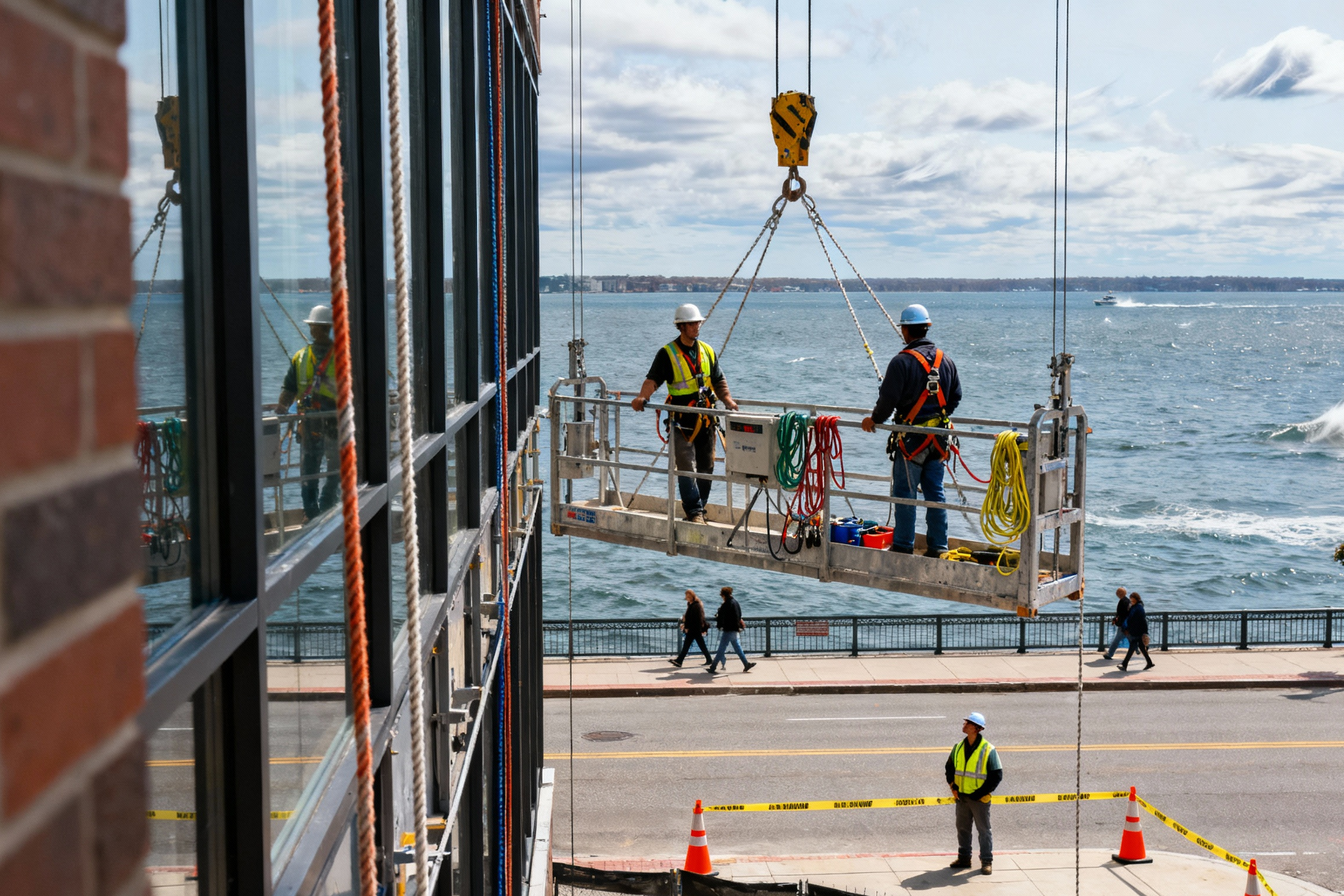
Swing stages make facade work faster and more precise—when they’re planned and used correctly. For crews and managers in Boston, MA, success starts before the platform ever leaves the roof. This guide turns standards into everyday habits: how to stage equipment, manage loads, read the weather, and keep logs tight so jobs stay on schedule and everyone goes home safe.
What a swing stage is—and why small details matter
A swing stage is a suspended work platform hung by two or more ropes and powered by hoists. The platform “swings” from roof rigging points so crews can reach windows, stone, panels, and sealants. Older buildings and tight streets around Boston, MA, often favor roof-based access, which means the quality of your setup on day one dictates the pace and safety of every drop.
Pre-job planning that pays off
Start with drawings, not guesswork. Confirm drop lines, parapet height, and any setbacks or recesses. Identify anchor or tie-back points, rescue pick points, and storage space for counterweights or davit gear. Walk the perimeter at ground level to note sidewalk closures and sensitive areas—especially important near schools and hospitals in Boston, MA. A 15-minute site walk prevents hour-long delays once the platform is on the line.
Platform setup: the sequence that keeps you honest
Lay out the platform, guardrails, toeboards, and end stirrups. Inspect decking for cracks, check fasteners for tightness, and verify that hoists are current on service. Wire ropes should be clean, straight, and properly reeved; lifelines must be independent of support lines and rated per ANSI Z359.1. Tag every component with a unique ID so rotating vendors in Boston, MA can match logs to equipment without confusion.
Roof rigging: outriggers, tie-backs, and edges
On many projects in Boston, MA, crews rig with outrigger beams or davits. Keep inboard length and counterweights as shown on engineered drawings. Use non-flowable, secured counterweights only; never substitute buckets or jobsite debris. Tie back each beam to rated anchors in straight lines free of sharp edges. OSHA requires tie-backs rated for at least 5,000 lbs or part of a certified engineered system. Protect ropes anywhere they contact parapet stone or metal with edge guards—ice and winter grit can chew through sheathing quickly in Boston, MA.
Load planning: know your numbers
Add up platform weight, hoists, tools, materials, and people. Respect the lowest-rated component in the system. Swing stage systems must be engineered to support at least four times the intended load per OSHA 1926.451(a)(1). Stage materials evenly and keep heavy items near the center. If you work across multiple buildings in Boston, MA, print a one-page load chart for each common platform length and laminate it at the roof hatch. When everyone knows the limits, fewer “just this once” decisions creep in.
Daily inspection rhythm
Use a short checklist before the first descent:
- Inspect wire ropes, terminations, and rope grabs
- Test hoist up/down, overspeed, and power cords
- Confirm guardrails, gates, and toeboards are secure
- Verify lifelines, connectors, and harness fit
- Recheck counterweights, pins, and tie-backs on the roof
- Log weather, wind, and the name of the competent person
ANSI recommends annual inspections by a qualified person, and OSHA requires pre-use checks before each descent. Keep the logbook accessible. Auditors and GCs in Boston, MA, will ask for it, and it’s your best memory when crews rotate.
Operating smart: smooth moves, clear comms
Balance the platform before leaving the edge. Maintain light, even tension on both hoists; avoid “stair-stepping” that twists ropes. Use a simple signal plan—hand signals or radios—to coordinate moves and emergencies. In busy corridors of Boston, MA, add a spotter at street level during the first drop to watch for pedestrians and confirm overhead hazards are clear.
Wind and weather: have an off switch
Coastal gusts, temperature swings, and sudden squalls can make a stable platform feel alive. Set conservative wind limits for your gear and stick to them. Post the threshold where crews stage, and check a reliable local forecast. Many teams in Boston, MA, stop work early when gusts exceed the limit or when ice forms on lines—finishing tomorrow is better than fighting the platform today.
Rescue planning that’s real, not theoretical
Assume a worker could be suspended on a lifeline or the platform could stall between levels. OSHA requires a written rescue plan for suspended access systems. Define anchor points for rescue, keep a lowering device on the roof, and train the team to use it. Run a short drill at the start of the season. Fire departments across Boston, MA, respond quickly, but your plan must bridge the minutes until they arrive.
Housekeeping and public protection
Tape and tag a clean drop zone; use debris nets for loose materials. Secure tools with lanyards and store small items in trays. Post signage where foot traffic is heavy. On narrow sidewalks in Boston, MA, schedule high-risk tasks for low-traffic hours to reduce exposure and keep tenants happy.
Common pitfalls you can avoid
- Running lifelines on the same rigging as support ropes
- Skipping tie-backs “just for one window”
- Overloading one end with materials
- Letting unauthorized personnel operate hoists
- Ignoring minor rope kinks that grow worse in cold Boston, MA weather
Quick checklist to copy
Plan the drop. Inspect the platform. Rig per drawings. Protect edges. Balance the load. Confirm comms. Watch the wind. Log everything. Post a simple rigging diagram at the roof hatch showing drop lines, tie-backs, and rescue anchor points. Reset the roof at the end of the day—many buildings in Boston, MA require the scene to be clear before nightfall.
Next step
Need the rigging points that make platforms possible? Read next: How to Choose the Right Anchor for Your Building to align anchors, tie-backs, and labels with the swing stage work you’re doing in Boston, MA.
Want a second set of eyes?
If you’d like a walk-through, a rescue drill, or help standardize logs across several properties in Boston, MA, we can step in. Explore Fall protection to connect with American Anchor for site reviews, drawings, and a right-sized plan that keeps your crews moving safely.


